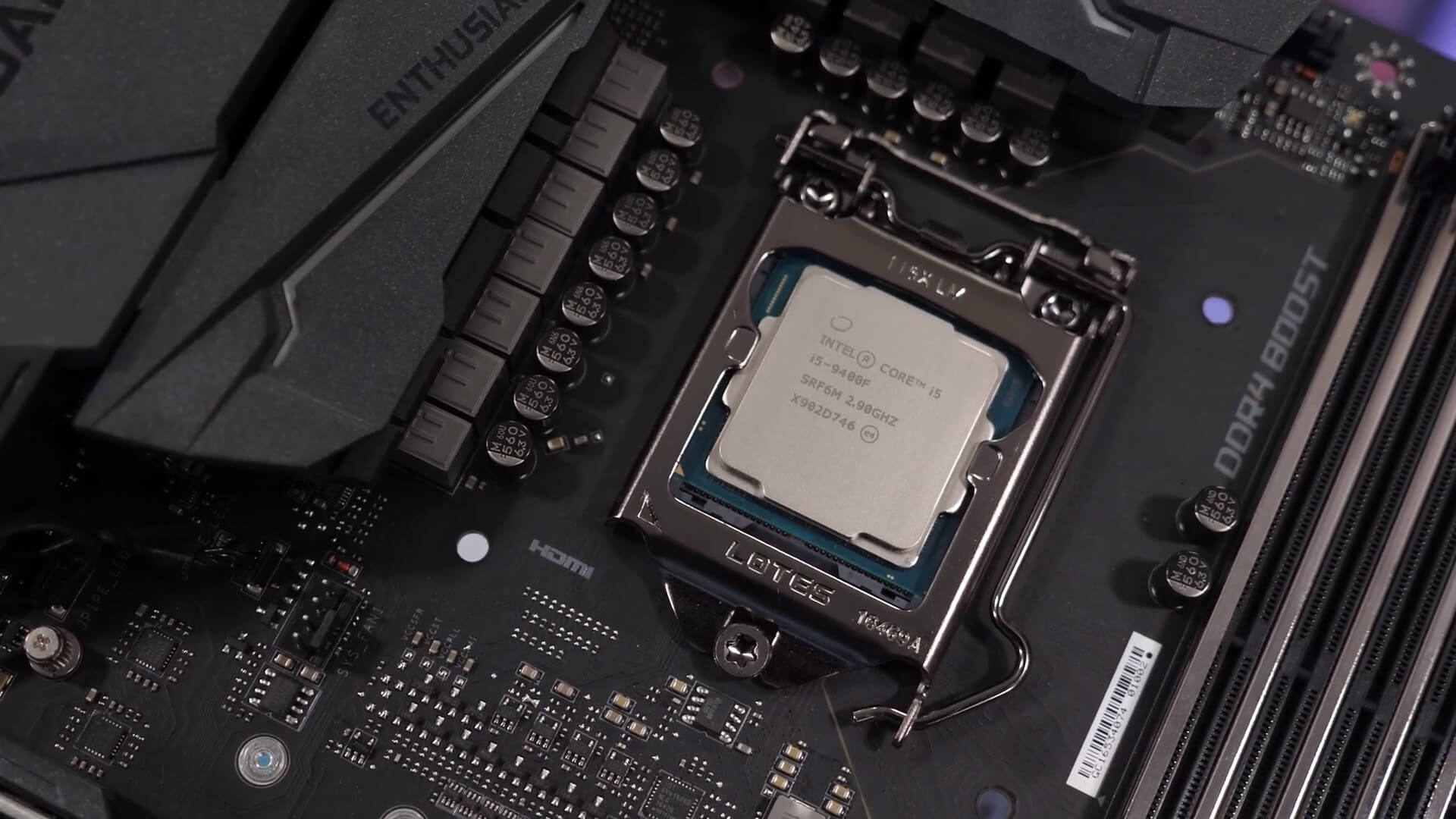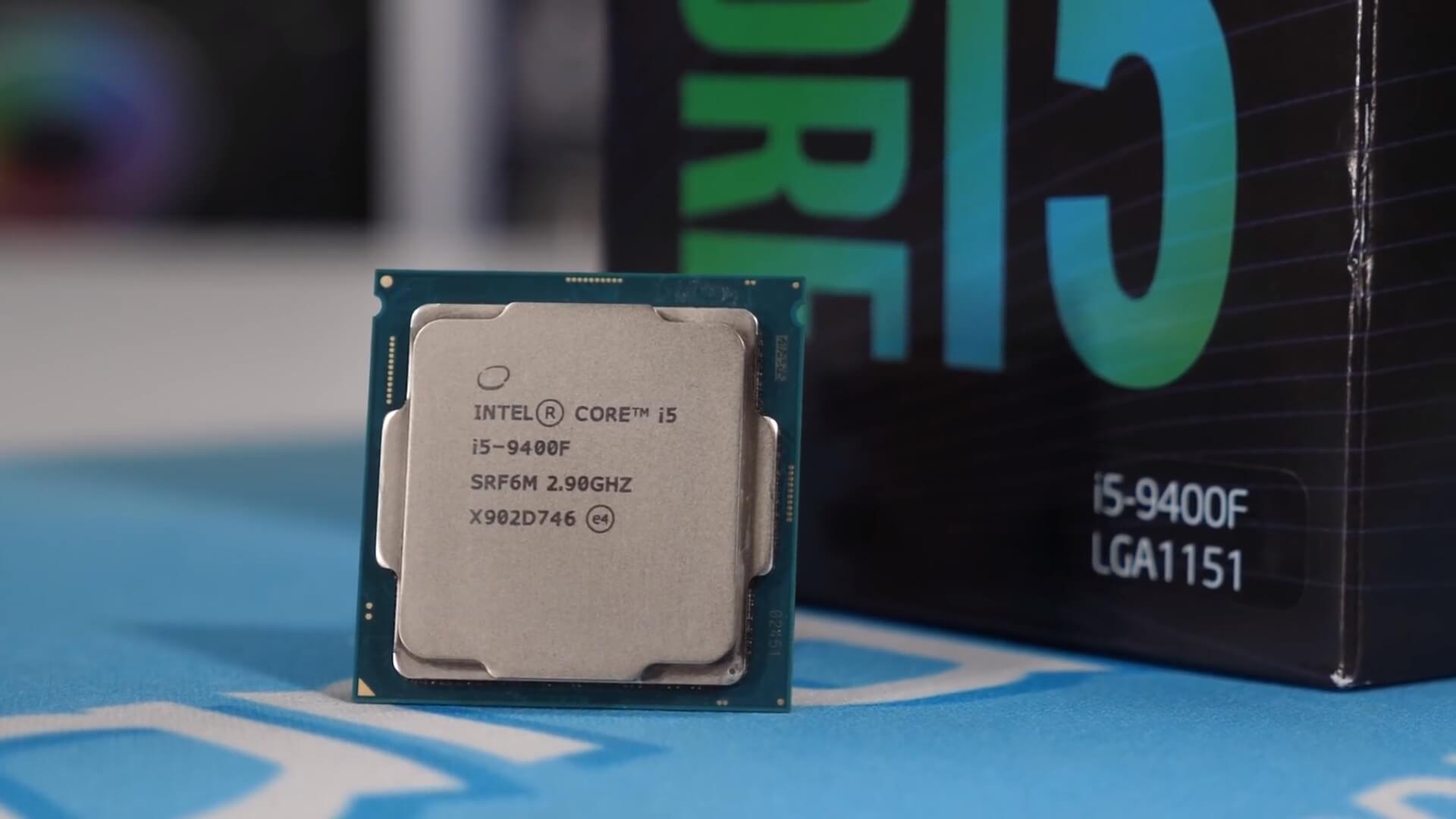Intel has been having some trouble as of late which has made it even harder to compete with the incoming wave of Ryzen processors. That has forced the chip maker to be a little more creative and make do with their current product lines. Today we have the Intel Core i5-9400F on hand, which in itself isn't anything new. It's basically a refreshed Core i5-8400 with a 100 MHz clock speed boost. We say basically because it's not a straight refresh however, there's another change.
The Intel UHD Graphics 630 have been disabled and therefore the 9400F has no form of integrated graphics – just like the Ryzen 5 2600X. This is meant to make the 9400F cheaper than the Core i5-8400, even though Intel's list pricing doesn't make this apparent, in practice the Core i5-9400F can be had for $175 while the i5-8400 is still $215, making the newer chip about 20% cheaper. It also means it's cheaper than the Ryzen 5 2600X which is currently retailing for $190.
So which should you buy? Let's get that out of the way. Before this comparison review we updated our Best CPU feature and we said you should go with the Ryzen 5 2600X as it comes with a better stock cooler, can be overclocked, and the AM4 platform offers a significantly better upgrade path.
We stand by that assessment, but that won't escape us from running a few up to date benchmarks. We'll focus on gaming performance which should make life a little easier for Intel's CPU. For application performance you can refer back to our day-one coverage of the Ryzen 5 2600X where the i5-8400 was included. You can safely bet the 2.5% factory overclock isn't going to make the 9400F any more than about 1-2% faster than those figures.
We'll also take a closer look at operating temperatures of the i5-9400F using the box cooler towards the end of the article as somewhat of a mini-review. The main event though is an 18 game benchmark using the GeForce RTX 2080 Ti at 1080p, 1440p and 4K. The 4K results should typically simulate GPU bound gaming using a lower end GPU at a lower resolution.
There are two test configurations for each CPU. The Core i5-9400F was tested with the standard Intel box cooler for both configurations on the Gigabyte Z390 Aorus Master. The base configuration uses 16GB of DDR4-2666 CL15 memory as this is what you'll be limited to on any motherboard not using a Z370 or Z390 chipset. Then we have an overclocked DDR4-3400 configuration.
The Ryzen 5 2600X has been tested on the Gigabyte X470 Aorus Gaming 7 WiFi with the standard box cooler for the base test with 16GB of DDR4-3400 CL15 memory. Then the second configuration is overclocked to 4.2 GHz with tight memory sub-timings and the Corsair Hydro Series H115i. All benchmark data was gathered fresh for this review.
Benchmarks
Starting things off we have Warhammer: Vermintide 2 and here we see at 1080p, for maximum frame rates, the 9400F was 13% faster than the 2600X when comparing base configurations. Overclocking the 2600X pushed it ahead of the base 9400F for the 1% low figure but then pairing the Intel processor with faster memory was enough to get it back on par and ahead for the average frame rate.
Similar margins were seen at 1440p and then quite interestingly at 4K the 2600X was a fraction faster, or quite a bit faster when overclocked with finely tuned memory timings. You'd expect the result here to be identical, as we are, or at least should be 100% GPU limited, but that wasn't the case.

Moving on we have Assassin's Creed: Odyssey. I wasn't expecting the Ryzen 5 processor to do particularly well here, so the results were surprising. The faster memory didn't help the 9400F while the overclock boosted the 2600X's average frame rate by 9%. Moving to 1440p we are GPU limited and much the same is seen at 4K.
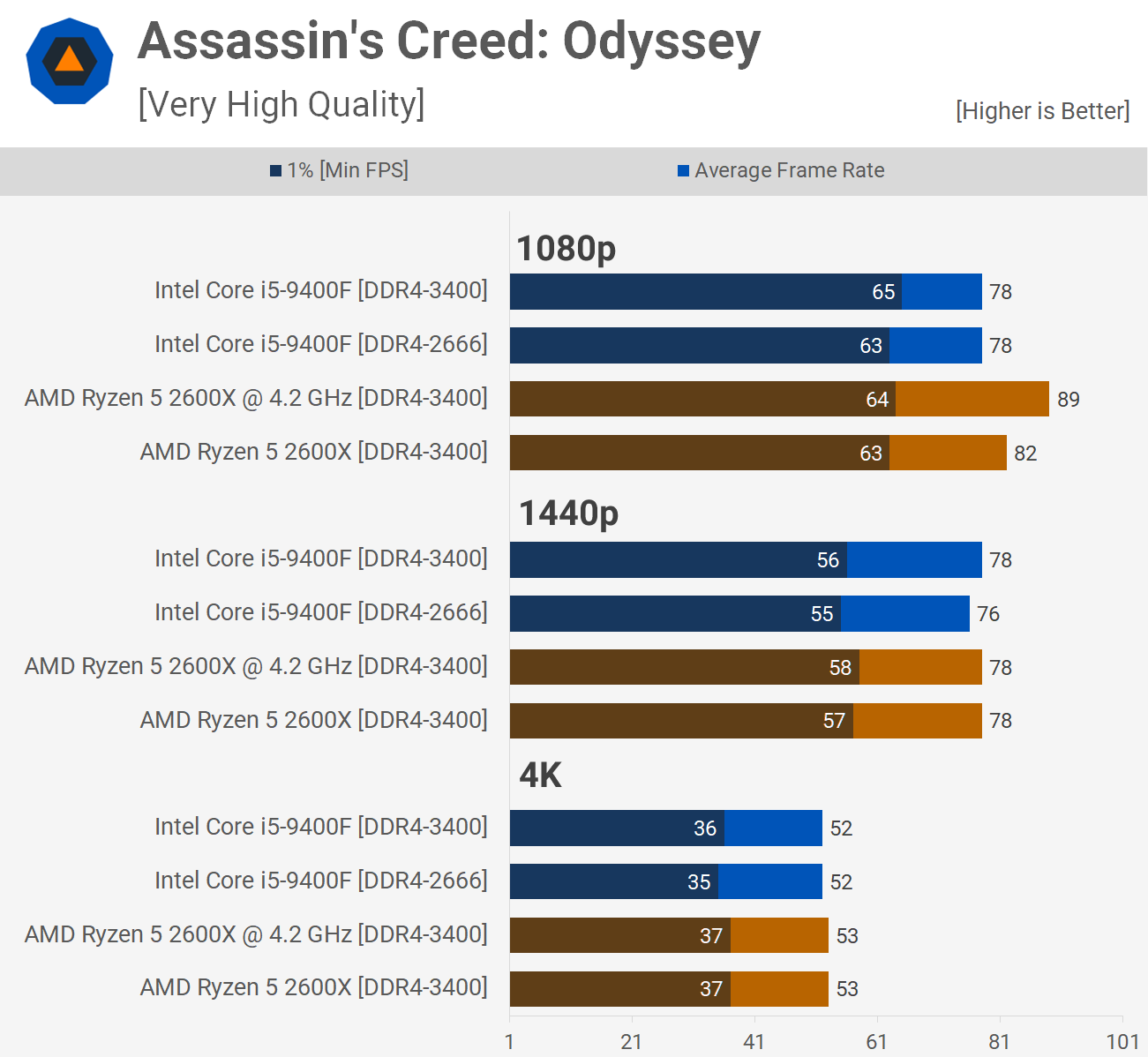
The Core i5-9400F was a little more punchy in Fortnite but overall the margins were insignificant, the fastest configurations were separated by 4% at 1080p. Naturally that margin was reduced further at 1440p and then at 4K we had a stalemate.

The 9400F was also a whisker faster in Apex Legends, nothing really worth getting too excited about though, essentially we're looking at the exact same experience using either CPU.

If you're for some reason seeking big frame rates in Resident Evil 2 then it seems like the Ryzen 5 2600X is the CPU to get, at least over the Core i5-9400F. At 1080p in its base configuration the 2600X was 8% faster and then 6% faster when tweaked for maximum performance.
That said these margins were effectively eliminated at 1440p and 4K, so for the vast majority of you these CPUs will deliver the exact same experience in this title.

Here is another example where the 9400F was faster by a small margin. When testing with Just Cause 4 the Intel CPU was up to 8% faster when comparing similar configurations, that said the 1% low results were much the same.

Hitman 2 is a horrible title for AMD and while the 1% low performance was competitive the average frame rate slipped quite a bit. This title is really bizarre when it comes to the relationship between the CPU and GPU, though I'd say we are mostly CPU bound at 1080p and 1440p.
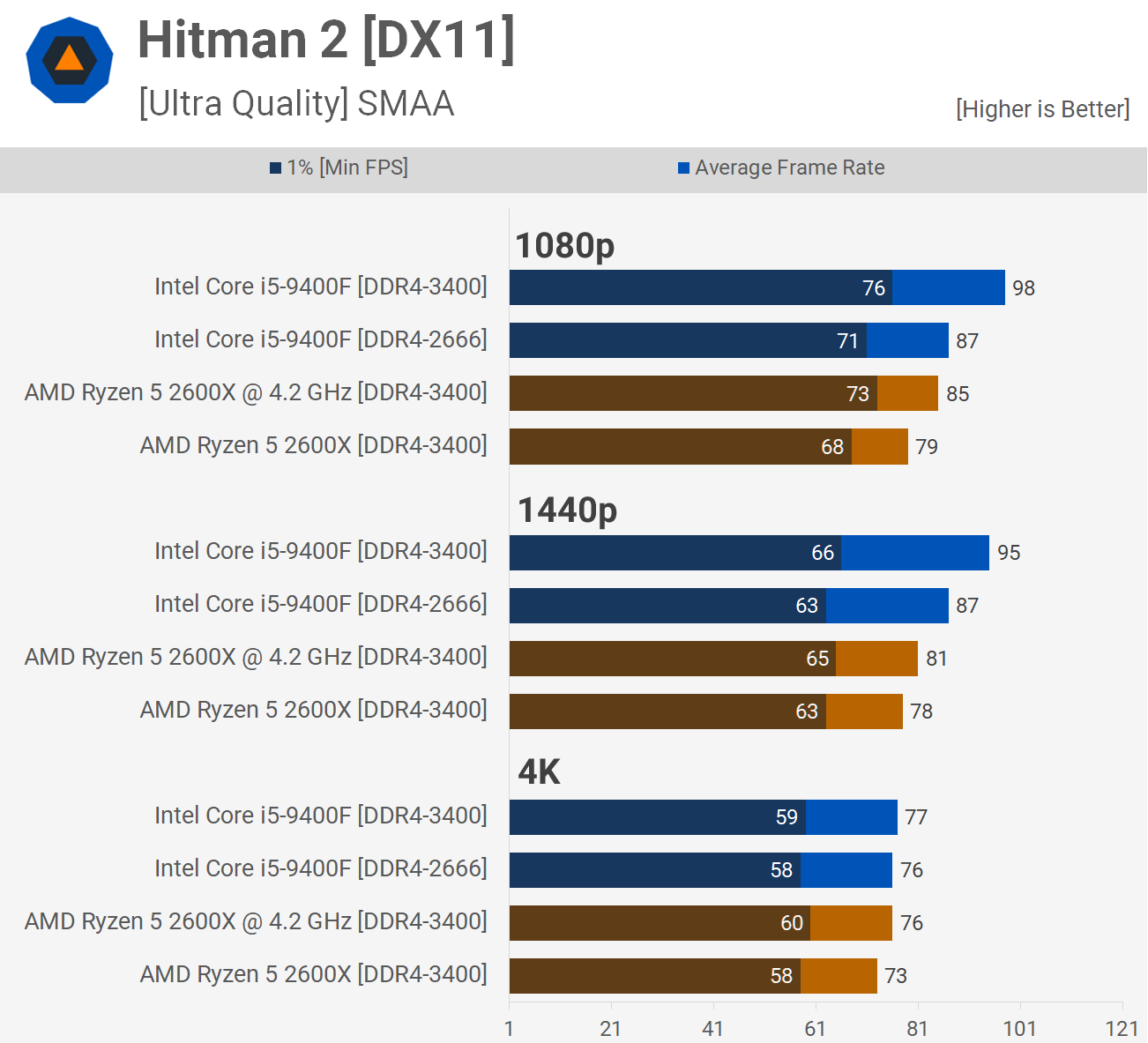
Project Cars 2 is another title that is not so friendly to AMD's hardware but overall the result isn't that bad for the Ryzen 5 2600X. We're CPU limited at the 1080p and 1440p resolutions, while things mostly come together at 4K.

The Core i5-9400F pulls slightly ahead at 1080p in Rainbow Six Siege for the average frame rate, but the 1% low figures are all very similar. There is very little difference between these two CPUs at 1080p and then basically no difference at 1440p and 4K.

The Battlefield V results are interesting... For repeatability and accuracy we are using the single player campaign. We've done multiplayer testing in the past but it's a little difficult to gather accurate data. It's also been several patches since our testing and many have addressed performance. The single player portion of the game mimics the slight issue we saw with the 9400F in multiplayer...
The experience with the 9400F for the most part was very good, but whereas the 2600X was silky smooth at all times, the 6-core Intel CPU suffered odd frame stuttering here and there. At 4K the 9400F with DDR4-2666 memory suffered big drops in performance though this was somewhat corrected with faster memory.
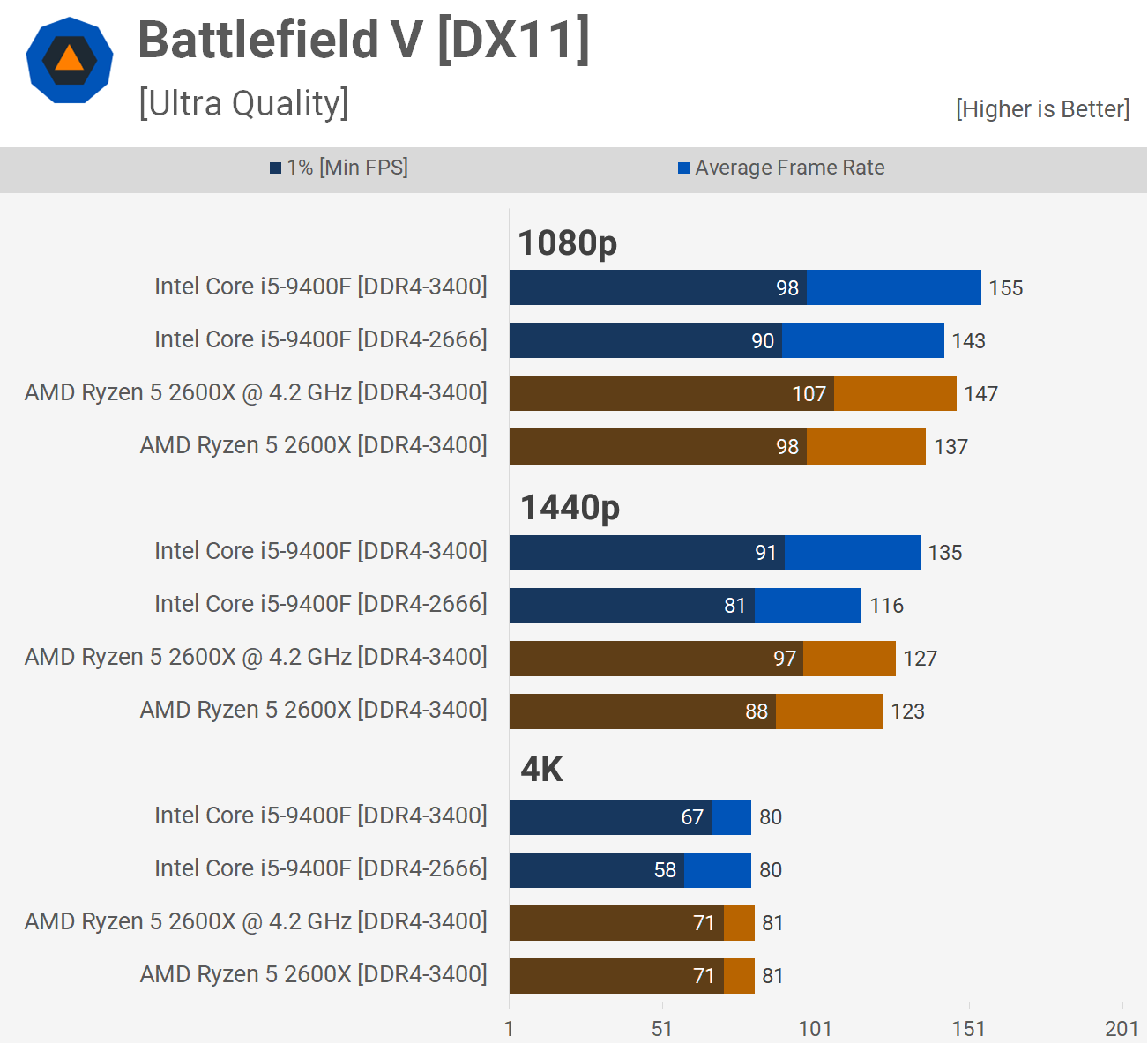
World of Tanks has been updated to support Ryzen CPUs optimally and we see the 2600X doing quite well. With over 100 fps at all times performance was very good and close to that mark even at 4K.

Performance in Metro Exodus was competitive and there was no distinguishing between the two processors. This isn't the most CPU demanding game out there but it was good to see the 2600X matching the 9400F in this modern title.

Far Cry New Dawn is quite sensitive to memory latency and turning up the Ryzen processor really helped here. The base configuration wasn't terrible but we did see up to a 15% performance boost from tweaking the memory and overclocking the cores. Even at 4K the 2600X struggled to get the most out of the RTX 2080 Ti without those tweaks.
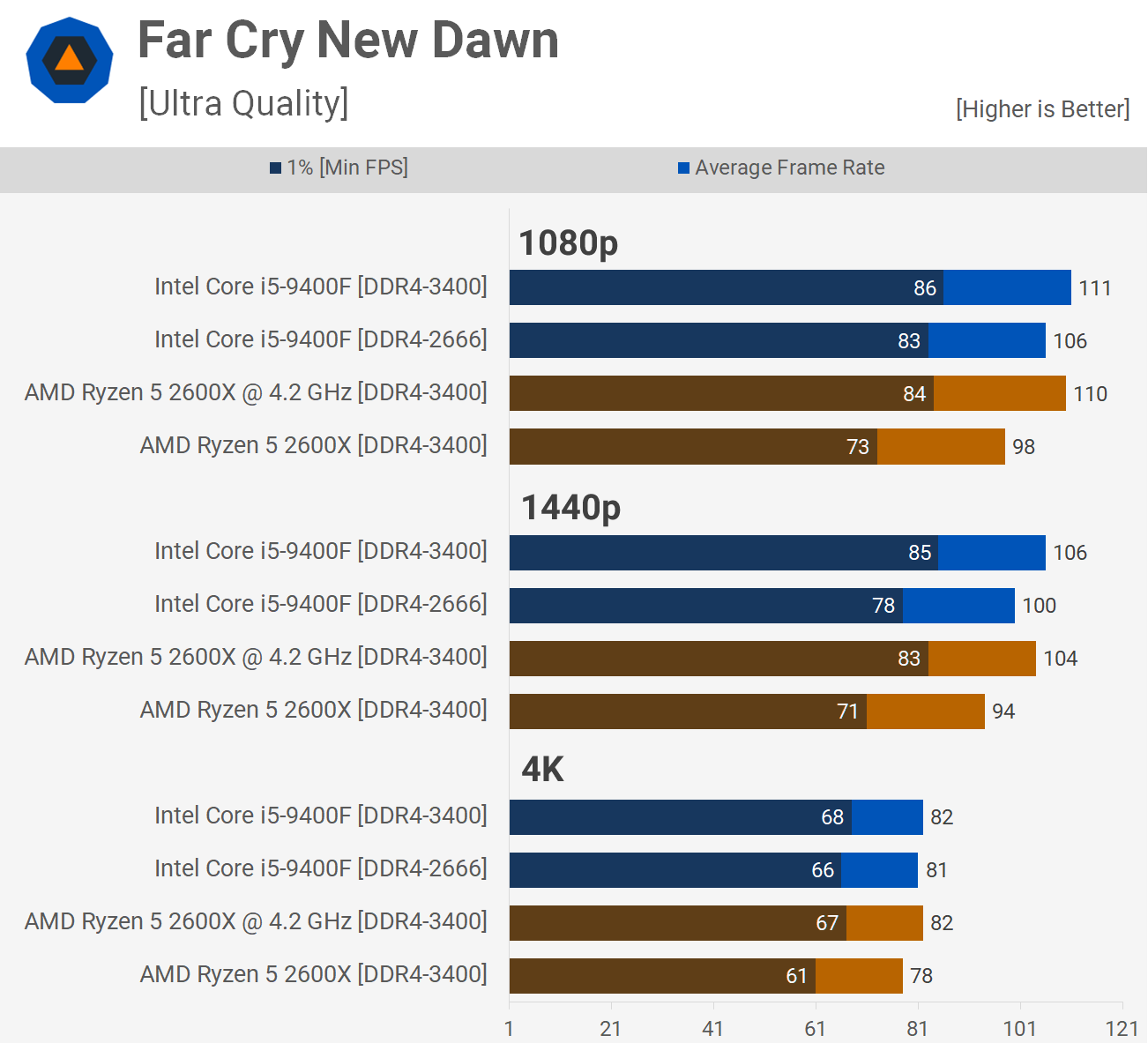
Both CPUs delivered similar performance in Shadow of the Tomb Raider and with DDR4-3400 both were able to max out the RTX 2080 Ti at 1440p. Then at 4K we were entirely GPU bound.
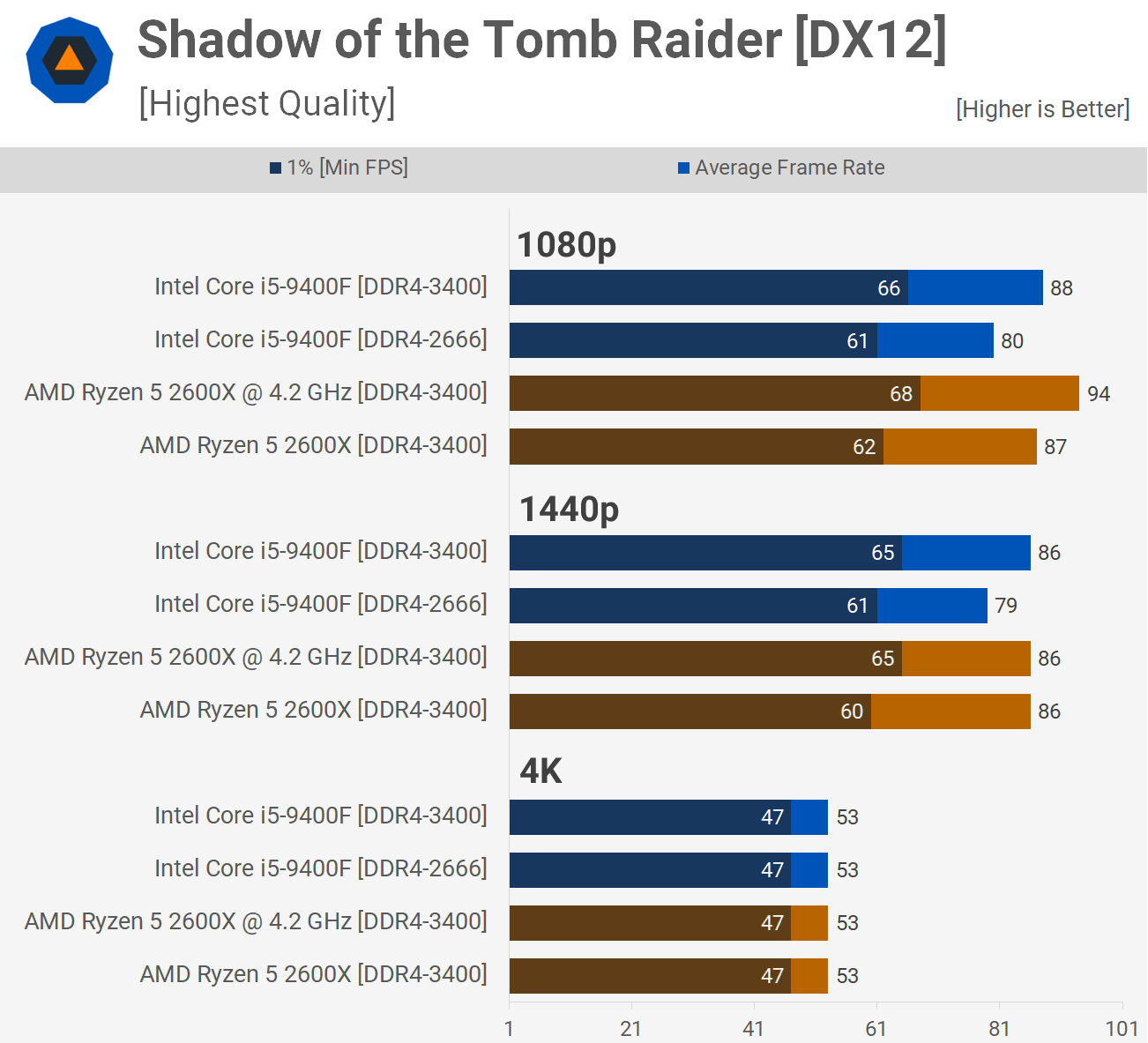
Using DDR4-2666 memory the 9400F was a little jittery in Monster Hunter: World, though that was solved with the faster DDR4-3400 memory. The 2600X had no such issue, though it was only tested with 3400 memory as this CPU has no memory limitations on any of the mainstream B and X series chipsets. Once we increased the resolution to 1440p the RTX 2080 Ti became the bottleneck.
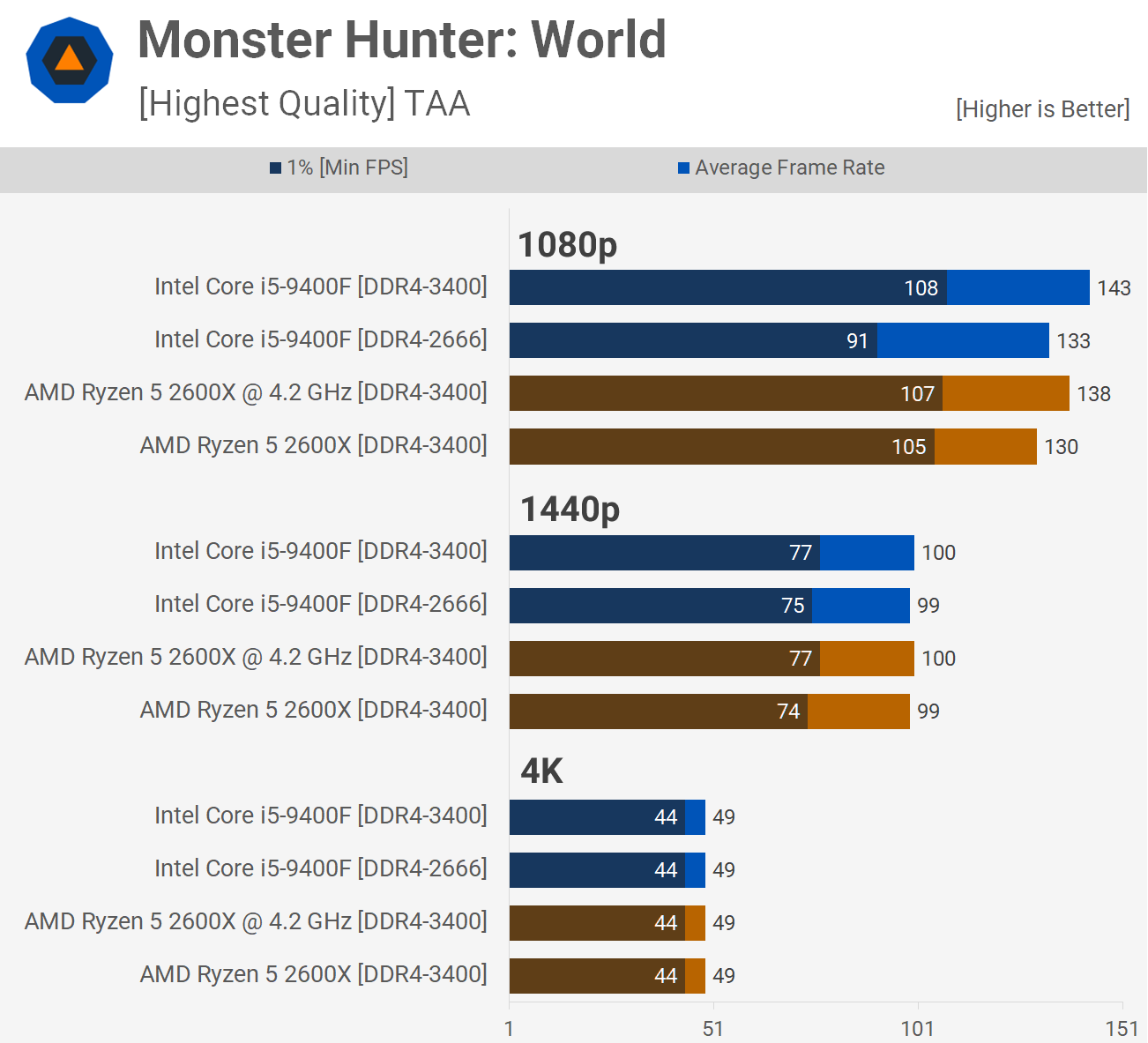
Strange Brigade isn't CPU intensive at all but it is very well optimized and allows us to test using the Vulkan API. Overall both CPUs performed well getting the most out of the RTX 2080 Ti at each resolution.

Despite putting on a good show in Battlefield V, the Ryzen 5 2600X isn't as nimble in Star Wars Battlefront II despite both games using the Frostbite game engine. The 2600X trails the 9400F even at 1440p, though once tuned up the margins are minimal.

Last up we have The Division 2 and these are some very interesting results to finish on. Using DDR4-2666 memory the Core i5-9400F maxed out at 120 fps on average with a 1% low of 86 fps. Then the faster DDR4-3400 memory boosted the average frame rate by almost 20% which is quite significantly.
This title appears to be very memory sensitive and we saw no issues with the 2600X which was only tested with faster memory. By the time we hit 1440p we are GPU limited with the RTX 2080 Ti and the same is also seen at 4K.

Closing Remarks
When it comes to gaming it's fair to say there's no wrong option here and the Ryzen 5 2600X and Core i5-9400F are evenly matched. The 9400F is at times faster thanks to better game support and lower latencies, but the 2600X is often able to ensure smoother frame rates thanks to its support for twice as many threads.
With the advantage of faster DDR4-3400 memory, remember the 2600X isn't artificially limited, it was able to match the Core i5-9400F using DDR4-2666 memory, a memory speed the Intel CPU is limited to on all but the Z-series motherboards.
Unleashing the 9400F with DDR4-3400 memory did offer a 5% performance bump on average while the 1% low was improved by 6%. The 2600X basically saw the same gains when overclocked. Those margins are reduced for both processors at 1440p, and then at 4K we're GPU limited to the point where you don't see more than a frame or two difference.

For general computing the Ryzen 5 2600X can take advantage of multi-threading capabilities and will be considerably faster than the 9400F on heavy application workloads. Remember the 9400F is only marginally faster than the 8400, so you can safely use the older model as a measuring stick. For rendering and encoding workloads the 2600X is anywhere from 30 to 50% faster.
For those wondering about operating temperatures, using the box coolers both CPUs run at a little over 70 degrees with an ambient room temperature of 21 degrees. However where AMD's Wraith Spire is whisper quiet in our Blender stress test, the Intel box cooler sounds like a jet engine when paired with the 9400F. Therefore, you'll want to spend at least another $25 on a decent cooler to make the thing bearable.
If you're mostly playing games on your PC, you will be happy buying either processor. Both proved to be solid options and are evenly matched with a slight advantage to the Intel chip if you don't tune up the Ryzen processor. The base performance we showed for the i5-9400F can be achieved with $90 memory, while the 2600X will require $110 - $120 memory in order to enable the frame rates shown here. It's not a big cost difference and right now with anything less than an RTX 2070 or Vega 64 you'll more than likely become GPU limited.
Looking at those 1% low results, the 2600X was arguably more consistent, but for the most part you wouldn't know which processor you were using. There can be exceptions to this such as older games. StarCraft II, for example, plays much better on Intel processors.
Moving beyond games, it's an easy win for the 2600X. The Ryzen upgrade path on B350, B450, X370 and X470 motherboards, all support upcoming Zen 2 processors. So if you buy a nice B450 board now with the 2600X, you'll be able to slap a Ryzen 3000 processor on there later in the year, or whenever you deem it necessary.
On that note, at this point we suggest holding off on any CPU purchase until the Ryzen 3000 series arrives, it's just around the corner.

